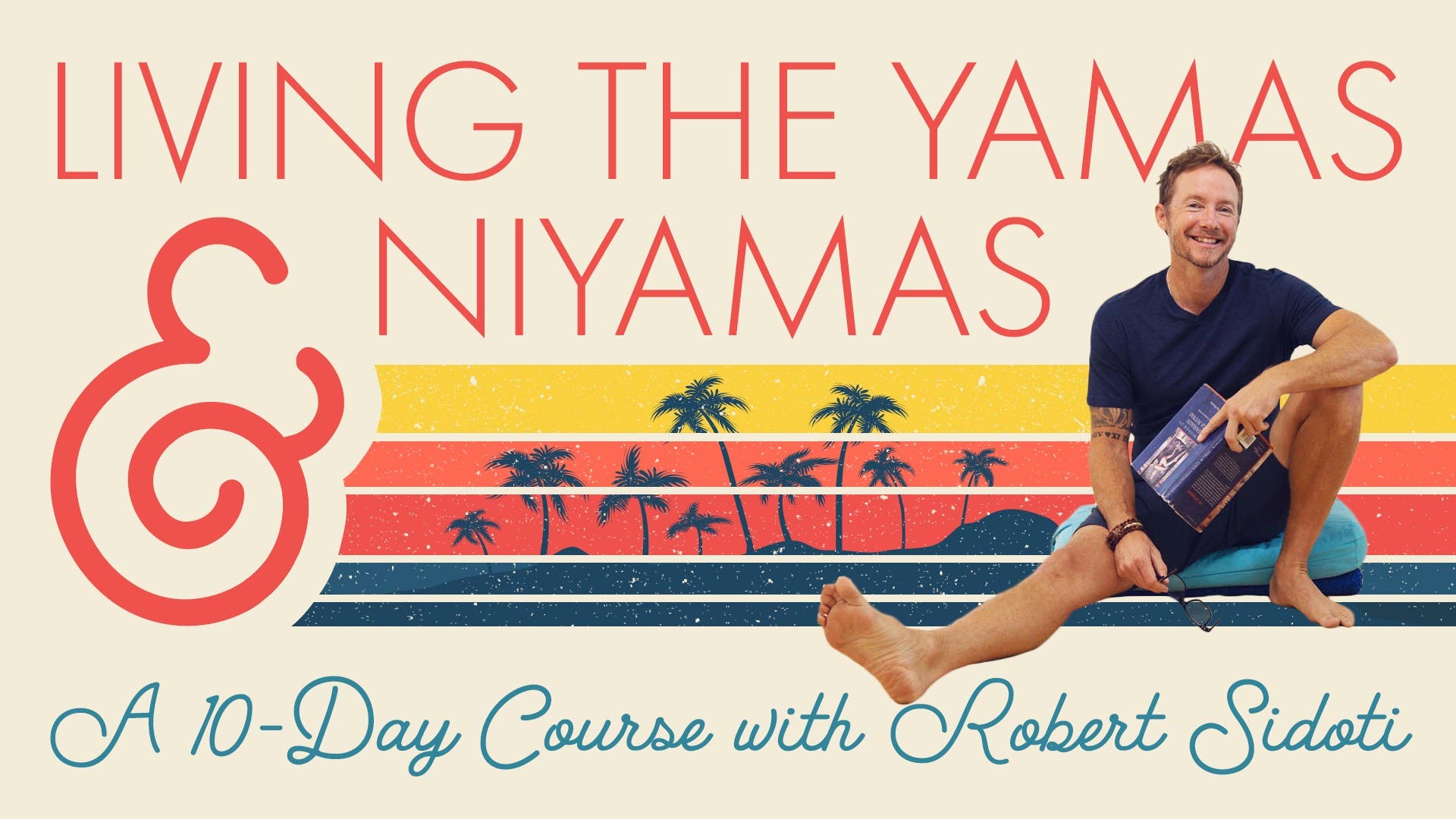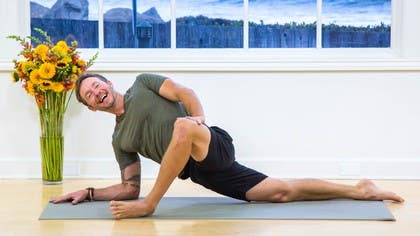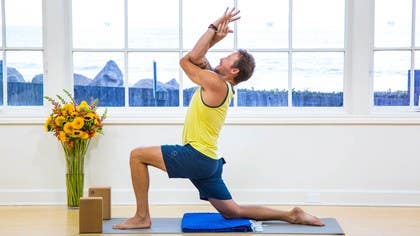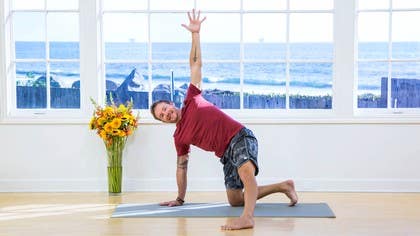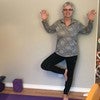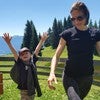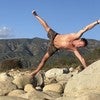Description
About This Video
Transcript
Read Full Transcript
Hey, welcome to yoga anytime. My name is Robert. I am super excited to be here and for those of you who have been practicing with me for a long time now, I couldn't be more excited for you to be here with me, all right? So thank you, thank you. Those of you who are brand new, nice to meet you, all right?
So we're going to talk a little bit about Ahimsa. This is known as non-violence, non-harming. As you move through your day, right, in life, where do you find yourself through either, you know, thoughts, through words, or actual physical action, harming something, yourself, something, someone, right? We all do it. We're all guilty of it, you know, whether you're driving down the road and somebody cuts you off and you might have some sort of internal harsh judgment against them, or maybe you come up short with something, right?
And you find yourself throughout the day in this negative loop, and that's just not healthy for you or anyone you come into contact with, right? So I'm not here to, you know, judge you or tell you that I'm right. These are all things for you to consider and to move through your day thinking about. Wow, you know, the more you're aware of it, the more you're going to feel like that didn't feel right, that didn't feel right, and how I presented that to that person or that thing, right? Okay, so it's just to recap it quickly.
This is non-violence, non-harming, how can you move through your day without hurting anybody and hurting yourself, okay? It might seem obvious, but pay attention. Now even more important as we're moving, we're here on the yoga mat, right? Where in your yoga practice do you find yourself pushing too much, all right? Pushing your body into potential injury, watch your thoughts, you know, if we're thinking about thoughts, words, and actions, pay attention to that, and who knows, you may benefit quite a bit from just that one principle of virtue, right, non-violence.
So let's lead in the practice with a quote. One of my favorite quotes, all right, Narayawahi goes like this, it's kind of nice, and I said to my body softly, I want to be your friend, like, ah, right? And I said to my body, I want to be your friend. Body took a long pause and a deep breath and said, I've been waiting for this my whole life, ah, you don't even know, I want to cry, but I'm not going to cry on camera. No, but that's, it's meaningful, right?
So how can we come home, come to your body, and be friendly, and be kind and compassionate, okay? So consider that as you're moving through this practice and every other practice. You'll benefit, you'll feel better, all right? So we're going to begin in child's pose. Okay, so move from your seat, however you're sitting into child's pose.
And in child's pose, for me, personally, I like to take, you know, the first one, I like to take my knees pretty wide, maybe I bring the big toes to touch, and using an exhale and moving softly, right, push back into the child's pose. And if you land there and you don't like it, right, or it feels uncomfortable, move away. Breathe in, come forward, and breathe out, move back into that space, and whatever little adjustments you need to make, you make them, okay? Think about this as you're going through your practice. You can do this a couple times.
I'll do it, you know, two or more, two or three more times myself. As I exhale, I move back, and you think about moving through the practice with this intention in mind. I am taking good care of myself, right? So if you've got that going on, and you are always in that mindset of taking good care of yourself, you'll figure out how to modify and adjust. Okay, let's take three breaths here in child's pose.
So extend the arms out. If you can place the forehead down on the mat, do so. If not, stacking the palms or the fists to place the forehead down is a nice way to adjust or modify or make personal for you. I think if we're going to be here three breaths, let's take three meaningful breaths and use your exhalation to soften some of those sticky areas in the body. Stretch it out, push the hips back, nice.
Let's take one more here, inhale nice and full, and an exhale. So from child's pose, let's come back to the table top. So we'll do this little series of movements that I'm a big fan of, all right? So the hands are somewhat below the shoulders, slightly forward is probably okay. Hands are untucked.
So the first part of the move is you inhale from child's into table, then the exhale, keep the arms straight, send the hips forward, keep the shoulders drawn back and down away from the ears. You start to feel a little something in the low back, maybe through the front of the hips, chest, good. So this is like your up dog with the knees down. Then we start to bend the elbows, dropping the hips down, the belly down, bending the arms, and coming through cobra in a reverse way. That's the exhale, and we reverse it.
Inhale back through cobra and through a little up dog, keeping the knees down, right? And you can kind of send the hips from side to side just to accentuate the little stretch on one side or the other. And then on the exhale, you exhale back into child's pose all the way back, stretching those arms out as much as you can. All right, let's try that again. So inhale into table, lower the hips, reverse up dog through cobra and down.
Inhale cobra, a little up dog action. Use your core to push back into child's pose with the exhale. All right, let's do that again. Inhale table, exhale lower down, and you can think about and feel like all the different joints in your body, the spine, this like nice hydration in the body, okay? Inhale cobra, little up doggy dog, back all the way into child's pose.
You can do that a few more times on your own or we'll meet in downward dog. So tabletop, spread those fingers out nice and wide, curl those toes and lift up, up and away in your first downward dog. I like to take my feet a little bit wider, tend to be a little tighter, you know, in the morning or the first downward dog. So this helps to create some freedom in the backs of the legs, also making it a little bit more accommodating in the spine, right? So a little bend in the knees, a little shift of that pelvis upward, sit bones up, good neutral long spine, then you can press one leg down, meaning, right?
So if you press your left heel down, bend your right leg, press your right heel down, and your left leg. From here, start to walk your hands back towards your feet into a forward bend. When you arrive, bend those knees, plant the fingers or the palms on the shins and lift up for a half forward bend. Pull the shoulders back, hips go back, spine is nice and long. Breathe in and as you breathe out, keep the knees bent and there's this little tip of the pelvis forward and you start to feel that grab in the hamstring and you forward bend down.
Let's try that again. Breathe in, come up, get that half forward bend, lengthening through the spine, breathe out forward and down. Take out the head, relax the arms, maybe hold on to opposite elbows and get a little sway from side to side. Okay release the arms, bend the knees, bring the palms down, if that's available, right? And start to walk back out into downward dog.
I like to bring the palms down and straighten my legs out a little bit just to kind of get the backs of the legs a little intensified, but not too much, right? Walk it all the way out into your downward dog, nice, good work. Let's take one full breath here, breathe in as fully as you can and empty it out. Do that again and notice that feeling of engaging and stabilizing in the pose, right, in all the areas, but letting go as much as you possibly can through the exhalation. So let's do it together, breathe in and exhale, let it fall out, you can kind of get lost in that exhale, it's pretty nice.
Let's walk the feet to the front of the mat, so you can do that in any old way you'd like. I'm going to keep my palms down as long as I can and keep walking one foot at a time forward and forward and forward and then for me it's like, all right, fingertips finish off the walk, land in a forward bend with my knees bent, relax, forward bend. Now straighten out the right leg, tent up on your left fingertips and roll that right arm high, high, high, creating a little twist in the upper body and a big long stretch down that right leg. Inhale lift a little bit more and exhale the right hand down, high on the fingertips, bend the right, straighten out the left as much as you can and inhale, so you want to like flatten out the back, almost like a half lift, right, and then rotate open, breathing in. Then we'll do one more on the other side, so exhale, exit, switch the bend and straightening of the legs, so straighten the right, bend the left and rotate open and bring him down.
Good, bend the right, straighten the left, rotate open, good work, left hand down, half lift on the breath in and fold, exhale. Little roll up to stand, arms heavy, head heavy, shoulders heavy, bent knees, tailbone drawing downward, all the way up, take the arms up overhead on the breath in and bring the palms to the center of the chest on the breath out, committing to that practice of the non-violence, non-harming and switching that, switching it to where can I be kind, where can I find more compassion, right, it's a nice thought, it's a really beautiful practice. So breathe in, reach the arms high, we'll get a little movement here and as you breathe out, put a little bend in the knees, forward bend, flat back on the breath in, breath out, fold forward, step the right foot back, so you have a nice long lunge here, walk the left foot to the left side of the mat, left hand comes up on top of the left thigh, right hand onto the mat, now there's a few things we're going to work on here, the first one is keeping the right leg straight, make sure your right hand is comfortable, now take that left knee and draw it forward, forward, forward, let it go beyond the toes if you've got that range of motion, we're working on some ankle movement, some ankle range of motion, alright, so we're doing that a few times and maybe you're also kind of dropping that right hip down a little bit to stretch up through the right side, you know, I'm giving you cues and suggestions but you're tuning in, right, you're figuring out in these two shapes I've got you in, where you need to go, where you need to go to go deeper to feel more sensation or where you need to back off a little bit, it's too much, right, you can't breathe, okay, now we start to straighten out that left leg and so I like to keep my hand up on the thigh, you can bring both hands on the inside of the foot or on the outside of the foot, so bend and straighten, coordinate your breathing with it, you know, ideally what you're doing is inhaling into the lunge and exhaling into that straight leg, straight-ish, right, one more time, breathe in, lunge, and breathe out, straighten it out, working through those sticky parts, back into the lunge, this time that knee is stacked up strong over the left ankle, let's open up into a big wide twist, so you're going to take that left arm, reach it up, get that stretch across the upper chest, you can even let that right hip dip down a little bit, you know, every once in a while while you're in these poses, right, check in with the breath, right, if you cannot breathe well, you've got to adjust, so open up a little bit more if that's calling you, maybe smile a little bit, left hand comes back down, very good, step the right foot up, so I like to straighten out the left leg, put a little bend in the right to launch the right foot forward, landing in a kind of a wide forward bend, flat back on the breath in, get that beautiful long spine, and fold, left foot back, alright, so the left foot draws way back, good strong left leg, now find the right hand position, could be the fist, could be the palm, you figure out what works for you on that left hand, right hand on the right thigh, and now we've got this movement, this movement of straightening and bending and moving your ankle, think about really like where can I get into my body, where it needs attention in that loving, kind, compassionate, unharming way, right, you know the other trick here, keep doing this, just find your own kind of organic free movement here, not only the physical but as I mentioned earlier, watch your mind and your thoughts, I think I have probably three things in my body right now I could be complaining about, like really negative and harsh with myself, but I choose not to, I know it's there, bothers me a little bit, but I choose to kind of focus a little bit more on sending myself some good positive thoughts, right, some vibes, let's twist it out a little bit, take the arm up, it's far too easy to complain and to give myself a hard time, so again notice, notice where you find yourself doing that, so we're opening up across the chest, getting a little spinal twist and a little hip stretch, bring that right hand back down, straighten the right leg, bend the left, step up, breathe in, breathe out, forward bend, tuck the chin a little bit, stretch out the back of the neck, root down through the feet, strong legs into the glutes, into the core to rise up, big breath in as you do so, and exhale the palms, right back to center, breathe in, reach those arms up nice and high and breathe out, forward and down, breathe in, half lift, breathe out, hands come down, walk back into downward facing dog, check in, acclimate to the new scene you're in, new shape, inhale into plank pose, bring the knees down, exhale lower, inhale cobra pose, maybe kind of flirting a little bit with upward dog, sort of in between, what's your back kind of interested in here, tabletop on the exhale, toes curled under on the breath in, breath out, downward dog, look forward, inhale and as you exhale, step, jump, whatever you'd like, whatever your preference is, I like to walk up to the front of the mat, forward bend on the exhale, inhale flat back, fold, exhale, inhale ground down to rise up, and exhale palms right back to center, inhale reach up and back, exhale forward and down, each movement meaningful, inhale flat back, exhale downward dog, inhale into plank, bring those knees down again if you'd like and exhale lower down, fold those shoulders back away from the ears, untuck the toes, cobra pose on the breath in, maybe a little upward dog, make those adjustments and downward dog on your exhale, lift the right leg up on the breath in and step it to the front of the mat on the breath out, now land it, bend the back heel down and we're going to start to move into these little side lunge type movements, the skandhasana, so what you're going to do is align the feet, so heel to heel might be nice, the whole back foot, the left foot is down, right foot I like to have a little 45 degree angle, so I'm not going to go much deeper than this right now, I'm going to keep my hands on the mat, lift the chest, say hi to you and then we're going to transition over to the other side, this side you can maybe even lift the heel and get a little deeper in the knee, you can point the right toes up, so I showed you the right side and now the left side, now why don't we take two or three times back and forth at our own pace, over to the right, over to the left, over to the right, exhaling over to the left, use your hands to support, one more time over to the right, probably feeling that in the groin quite a bit, some hamstring, action, good. Now we come back to center, toes pointing forward, straighten out those legs, wide leg forward bend, so what we're going to enter that is come up onto the fingertips, this allows you to flatten out the back, you can put a soft bend in the knees if you'd like, so you've got that back nice and flat, you could even like push the palms of your hands into your hip creases, wiggle the spine a little longer, breathe in, as you breathe out, stabilize legs, come down into your forward bend, see if you can use your legs as most of what's holding you up, right, if you need to use your hands, use your hands, you could hold onto opposite elbows here, you can take your hands onto your feet, come back to the breathing and do everything you can in these shapes and movements and sequences to treat each posture as kind of a, you know, this is it, this isn't a means to get to the next pose, drop into the experience, feel your body, watch your thoughts, okay, so from here you're going to walk back over to the front of the mat, right foot forward let's say, so we're on the same page and send the left knee to the mat, we're going to work into lizard pose, all right, so both, so lizard pose hands can be flat, fingertips, blocks if you need them, right foot is out to the right side of the mat, all right, back foot untucked, you can drop that left tip down a little bit, so a little bit more hip work, okay, if you've got the space you can bring your left forearm down, maybe even your right, so lift the arch, you can see if you look, the arch of my right foot is lifting, if you've never done it before you start to really open up the hip quite a bit, okay, this will create a little bit more space for you to explore, this is one of those poses it either feels amazing or it feels like why, why am I here, so come to the breath, always using the exhalation as a tool to soften, soften the harsh critic within that head of yours and soften some of those body areas, body parts that might be overdoing it, okay, pigeon pose, so now you're going to come up out of lizard, walk the right foot to the left side of the mat, all right, now right knee comes onto the right side of the mat and you're going to have to kind of find your angle of right shin, some are going to be you know pretty angled, some of you might have more of a parallel chin to the front of the mat, you're going to have to feel your way around in this, I've got a like a 45 degree bend myself, now if your butt is lifted up high off the mat, maybe you put a blanket, a pillow or something to give you some support, we'll be here about five breaths, so I'd like you to figure out how to create that best possible shape for you, feel the sensations, right, the purpose of the pose, your breath, thankful for what is, you can stay upright, you could also kind of come down a little bit further onto your forearms or you can lay flat out, and I said to my body softly, I want to be your friend, it took a long breath, and set up and waiting my whole life for this, so sweet, okay, start to come back out, the transition is downward dog, take the right leg from downward dog, lift it up, it might feel nice to actually even open up that hip, so the right leg bends, stack that right hip over the left, keep driving that left heel toward the mat, what feels nice for me is if I come up high on my right fingertips and open the hip even more, sometimes I get a little cramp in that left side of the buttocks, call that the glute, your rear end, so this little cycle in and out, and I get the hip open, feels nice, right foot down, settle into your dog pose, take the left leg, lift it up, and we'll do this little lizard pigeon on the other side, so step the left foot forward, bring the right knee down, okay, acclimate to this space now, and you start to, from here, or wherever you've landed, start to undo, open, create space through conscious paying attention and breathing, you can stay up nice and high, or you can start to descend down into a deeper space if that's, you know, suitable for you, interesting, feels necessary, you know, and I think about that quote, that coming back to yourself, right, I feel like even neglect, that's harmful, right, that concept of neglecting the body, not paying attention, not giving ourselves that kind of compassion and kindness, so whenever you can, as you are now, coming back to the body, and that's just in and of itself, stop right there, that's meaningful, let's take one more together, one breath, breathe in, and let it all out as you breathe out, pigeon pose, walk back up onto the hands, come back a little bit, walk that left foot over to the right, find your position, right, find it, don't put yourself into an unnecessary position and sit there and suffer, you know, figure it out, you can also drop the whole left side down and create more of that yin style pigeon pose, you can also do pigeon on your back if this is totally unacceptable for you, so if it's good for you, stay here with me, or find your own way for a few moments while we take about five breaths in pigeon pose, calm, relaxed, doesn't mean it's easy and it doesn't mean that you're not having a hard time, but figuring out ways in the discomfort to find peace, to reduce tension, one more breath together, inhale, exhale, let it all go, so healthy, just feels healthy to do that, right, nice, okay, so let's take that same transition, curl the back toes, lift that left leg up into three legged dog, that just feels nice to stretch it out, bend it, open the hip, tent up on those left fingertips if that brings a little extra sensation up through the rib cage on the left side, relax the head, roll through that hip joint a little bit, right, that ball and socket hip joints meant to move quite a bit, so taking that opportunity to do that, left foot back down, downward facing dog, on your next exhalation, land the knees softly onto the mat, pause and table, breathe in, breathe out, child's pose, okay, from child's pose let's come on up into a kneeling position, I would recommend curling the toes under, number one, curl the toes under, pretty intense stretch for the feet which is good, okay, we're gonna work into camel pose which is considered a back bend but let's not back bend into our low back, let's open up the chest, let's open up the heart, open up the shoulders and elongate the spine to do so, okay, so with that come on up, now you know right now if you need to get a pillow, a blanket or something for your knees to make, you know, we don't need to make it harder than it is, so make yourself comfortable here, now it's all about the adjustment in the pelvis first, we want to take that tailbone and extend it downward, okay, draw the tailbone down, you have probably engage your glutes a little bit to do that, you might even feel this stretch or lengthening up through your hip flexors, right, the front of your hips and right there, that's a win, camel pose, you can place the hands back at your waistline, hold on to your low back, your butt to really help draw that tailbone down, pull the shoulders back, elbows toward one another, there's another camel pose right there for you, just kind of breathe across the chest and shoulders, alright, you can keep your left hand at your low back, reach the right arm up, rotate the palm back and down toward that right heel, alright, you can stay there and pull the left shoulder back, draw the hips forward, use your thighs, use your butt, right, those glutes, pull up on the heel, so it's like a little half version, alright, so keep the hand on the low back to exit out, right arm can come back up and down and let's switch it up, right, so we'll do some singles first, so the right hand shoulder pulls back, draw the belly in, tailbone down, left arm reaches up, palm toward that left heel, grab hold of it to pull up, then draw that right shoulder back and down, right, I'm working to try to get square here, my low back feels awesome, I'm feeling really most of a stretch in the upper body, back out, relax the arms, adjust, tailbone down, let's come into both hands now, so I'm gonna circle the right hand back, left hand back, boom, see how I've kind of leaned back a little bit, I haven't changed the position of the pelvis though, so the pelvis is still neutral but what I'm gonna do now is pull up on the heels, chest forward, hips forward, maybe even let the head drop back a tiny bit, be kind, not forcing anything, still breathe and talk, engage the core, left hand left hip, right hand right hip, up to neutral, untuck the toes, inhale and exhale, sit back onto the heels, knees draw toward one another, this will help to actually get more of that low back stretch and flexion, we come into more of a balled up flexed child's pose, also known as like rabbit pose where you bring the forehead toward the knees, hands toward the heels or toward the feet, let your shoulders relax, a little harder to breathe fully with the stomach and chest right on the thighs, so that's normal, beautiful, we come out of there, okay, seated forward bend, so come onto your seat, plop yourself up as high as you can, you can sit on a blanket or some kind of pillow that gives that pelvis that little lift, the forward tilt, toes up, legs can be a little bit bent but make sure those legs are active as you reach the arms up on the breath in and exhale, forward fold, this has never been, for a long time it really wasn't my favorite posture, felt like I was always, I entered it with a real frustrated negative mind, I could only touch my shins but over time through kind of like a gentle approach, conscious breathing, you know, practice, here I am now, here, point is, is I found a nice shape that stretches my back, stretches my legs, so how can you find that shape that suits you and when you land there feel totally fine, here I am, awesome, let's come up, alright, seated twist, so I'll face you because I haven't seen you in a while, you can place your legs, this is a seated spinal twist, you can cross your legs into like a half lotus, a full lotus, whatever cross-legged position suits you, alright, so take the time to build that, sit bones kind of draw back, pelvis shifts forward again so that you create that good foundation so that you can elongate and sit upright with good posture, we want to start a spinal twist with good posture, so let's take the arms up on the breath in, on the breath out, kind of like a helicopter, arms out and rotate to the right, left hand on the right thigh, right hand back behind you, you can use your arms to kind of deepen the twist a little bit, remember right, relax the shoulders, long healthy spine and in a gentle gaze maybe over the right shoulder or somewhere in between the left and right shoulder, somewhere where your neck feels, good, breathing through the belly on the breath in and gently contracting the belly using your diaphragm on the breath out, okay, relax the arms, right back to center, breath in, breath out, breath in, arms up, breath out, rotate to the left, right hand, left thigh, left hand back behind you, kind of like a strong post and pillar, okay, use those arms to set yourself up for good posture, we always want to align, elongate to twist, so think about that and then while you're twisting and there's some effort here, where can you not try so hard, not force, all right, relax the arms and let your body, nice, if it's interesting to you, you can take either this pose, right, chest open, sort of like a seated camel or fold forward, starting to slow down, all right, come on up, find a relaxation, little shavasana action, all right, so spin around however you'd like and immediately set yourself up for your most comfortable relaxation, take a deep breath in and exhale, I'm going to personalize this one and draw the bottoms of my feet together and let the hips open, arms are resting on my inner thighs maybe even on the belly, switch gears in your breathing, comfortable breath in, extended comfortable breath out, so it's almost like just let the breath fall in comfortably and fall out a little bit longer than you're used to, this might stimulate that, stimulate the body into this space of feeling relaxed, I've done enough for now, you've earned this short relaxation, scan the body, you find or feel or see areas of the body that are tense, make a conscious effort to relax them, soften all the facial muscles, this idea and feeling of really like letting go, you can join me in working up to a seat or we can finish off with you lying down, you can make that choice, so if you're sitting, make yourself comfortable, hands resting on the thighs, maybe even the eyes nice and closed, just coming back to that closing part of the practice of what we're doing here, we're practicing, remember practice, practice, practice, practicing this non-violence, non-harming, where in your day do you find yourself doing that, so just think about, feel into those moments and it's really about noticing, okay, it's about noticing when you are acting in that way and I'm not saying that as a perfectionist up here, I do it all the time myself but what's beautiful about the yoga practice is that now you have this sense of these tools, you have an awareness, so there's a quote I'd like to close with, very meaningful and very helpful in this practice, the Sahimsa practice, right, Viktor Frankl, it goes like this, between stimulus and response there's a space and in that space lies our freedom to choose how we respond, okay, and in our response lies our growth and our freedom and whatnot but it really does make a difference, if you take that moment when you're stimulated by whatever it is, find yourself in that space and think about and feel into a different way you can respond that might be healthier for you, the environment, for the other person involved, whatever it might be, so with that said, thank you, thank you for being here, I'll see you at the next practice, namaste.
Living the Yamas and Niyamas
Comments
I’ll be back tomorrow
You need to be a subscriber to post a comment.
Please Log In or Create an Account to start your free trial.

